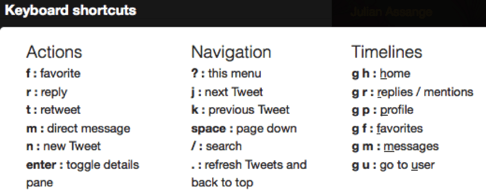The New Twitter Cheat Sheet
Nov 02, 2011 Beth Monaghan
Private Group Chat, Backups, Acknowledgements, Hashtags and More
Back in April I posted our first Twitter cheat sheet, and since then, a few of the Twitter terms have waned, new tips have come forth, and we’ve discovered some third-party tools that make Twitter easier to use (namely, private group conversations!).
If you are new to Twitter, Twitter has a handy page with 31 Twitter basics for getting started. For those who’ve been on Twitter for a while, please feel free to add your own tips to the comments below.
Third-Party Tools That Work
- !b = Private group chat for Twitter. I wish I thought of this! You don’t need to be following each other, and you don’t need any special downloads. It works everywhere – desktop, mobile phone, you name it. The folks at !Blether launched it yesterday. And in case you’re not Scottish, Urban Dictionary has a useful definition of “blether,” which means: n. 1. person who chatters incessantly; one who babbles on and on. or v. 2. to engage in conversation, long-winded or idle talk. To use it simply login at http://www.blether.co/ (you can use your Twitter credentials) and type “!b” followed by any list of Twitter handles. For more details, check out Courtney Boyd Meyer’s story on TheNextWeb.
- Backup Your Tweets. You’ve no doubt discovered that Twitter only keeps tweets for the short-term. If you want to back them up, check out TweetBackup and Backup My Tweets.
Acknowledging Others
As I mentioned in my post, Tweet Like it’s a Networking Event, acknowledging other people’s ideas and finds is important in the real world and the social media world alike. Here are a few ways to acknowledge others on Twitter:
- via = I found this information via someone else. Due in part to automated tweets on news sites, Twitter users have begun using the term “via” to acknowledge other Twitterers. For example, if I found a story and wanted to write my own tweet instead of RTing someone else, I might write a tweet such as this: “The intertwining of luck and genius: Bill Gates & Southwest Airlines from @nytimes nyti.ms/vigNYP via @joshandrix”
- HT = Hat tip. This is a way to virtually tip your hat to another Twitterer. It can be a congratulatory tweet, or perhaps you just liked the article the person wrote. Use it as you feel it’s appropriate. There aren’t set rules for this one.
- #FF = Follow Friday. Follow Fridays has been around for a while and it’s a way to suggest other Twitters your followers might want to follow. Instead of blind tweets with #FF followed by a bunch of handles, I suggest adding context. For example, “#FF to my favorite foodies in Boston @abcdefg @hijklm”
- Favorite. You can favorite someone’s tweet, which is another nice way to acknowledge him or her publicly. I would use this option if the tweet contains information you’d like to refer to later.
Getting Fancy
- Hashtags can convey humor, foster conversation during live or virtual events and rally support for major campaigns (think “#OWS” that is being used by the Occupy Wall Street demonstrations).
- OH = Overheard. It’s a good way to share the funny things you happen to overhear everyday, and it’s a great way to add personality to your tweets. No one wants to follow a robot.
- Keyboard shortcuts. If you’re using Twitter.com here is a screen shot from Twitter on the keyboard shortcuts:
The Standby Twitter Abbreviations
- RT = Retweet. Put an RT in front of a message to rebroadcast someone else’s tweet to your followers.
- MT = Modified tweet. Similar to a retweet, this means that you are passing along a tweet from someone else, but have modified it from its original form. I should note that “PRT” or partial retweet used to be used a bit, but I have not seen it in months, so I think we can call it a thing of the past.
- @ mention (public and semi-public). An @ mention happens when someone else mentions you in a tweet. If the @ mention is at the beginning of the tweet (e.g. @bamonaghan Thanks for the RT today), only that person, and the people following you and that person can see the message. It’s NOT private though. If you want everyone to see an @ mention, simply embed it in the middle of a tweet (e.g. Great seeing @moleary today) or place a period before it in the tweet (e.g. .@moleary and I had a great meeting today).
- D = Direct message. These are private messages that only you and the sender can see. The person you are DMing must be following you though for this to work.
- CC = Carbon-copy. Works the same way as email.


.png)




